Science & Technology - 2018
February
Scientists Take Aim at ‘Eye-Safer’ Lasers
Superconductive Coatings May Float NIF Targets
Magnetic levitation is now, and it’s here. It’s been done with trains and even frogs; now it’s being attempted with tiny NIF fusion fuel capsules.
The concept behind an ambitious NIF target fabrication program is to levitate inertial confinement fusion (ICF) capsules inside hohlraums, harnessing the physics of superconducting levitation.
In ICF experiments, researchers have been striving to minimize the impact on implosion performance from capsule support hardware like tents, fibers, and fuel fill-tubes—micron-sized though they are. Reducing perturbations from these engineering features, they anticipate, will help maximize the neutron yield from NIF implosions (see “Perfecting the Spider’s Art to Support NIF Targets” and “Working to Tame Disturbances in the NIF Force”). 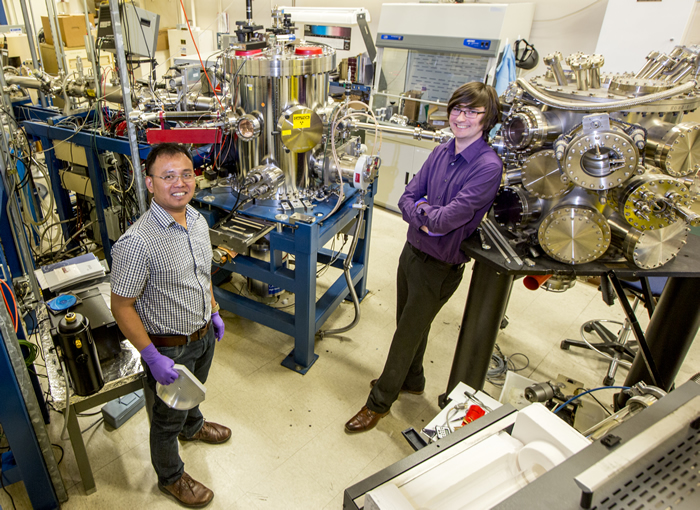 Team members L. Bimo Bayu Aji (left) and Alex Baker in the laboratory in Bldg. 235 where superconducting coatings to levitate NIF target capsules are being developed. Credit: Jason Laurea
Team members L. Bimo Bayu Aji (left) and Alex Baker in the laboratory in Bldg. 235 where superconducting coatings to levitate NIF target capsules are being developed. Credit: Jason Laurea
For one possible solution, a team of LLNL scientists led by physicist Sergei Kucheyev has been developing superconducting coatings on capsules to enable magnetic levitation—because, as with all technology, “magnets make it better.”
“Levitation is an ideal solution to get rid of the undesirable perturbations from the capsule support hardware,” said Kucheyev. “The levitation approach offers a completely interference-free solution.”
The project is a collaboration involving the Laboratory’s NIF & Photon Science, Physical and Life Sciences (PLS) and Engineering directorates and General Atomics. Along with Kucheyev from PLS, team members working on targets in NIF & PS include Scott McCall, L. Bimo Bayu Aji, Alex Baker, and Elis Stavrou (PLS), David Steich (Engineering), and John Bae (General Atomics). Their work has been supported by the Laboratory Directed Research and Development program (LDRD).
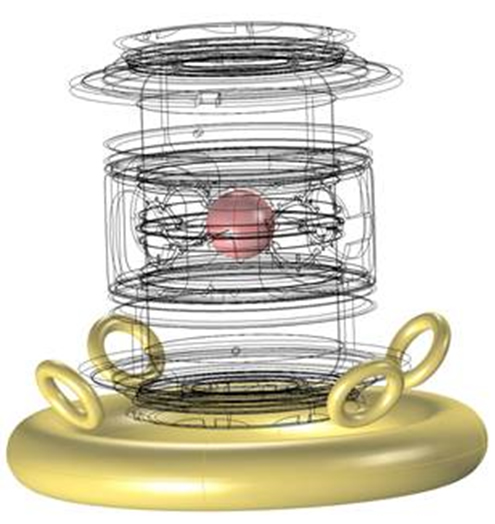 The capsule is coated with a thin (about 100-nanometer) superconducting layer and supported by an upward Lorenz force generated by magnetic coils outside the hohlraum.
The capsule is coated with a thin (about 100-nanometer) superconducting layer and supported by an upward Lorenz force generated by magnetic coils outside the hohlraum. In order to entirely eliminate perturbation-causing mechanical support, capsules are coated with a thin film of a superconductor called magnesium diboride (MgB2), currently the most promising material. The superconducting coating can be less than 100 nanometers (billionths of a meter) thick. The levitating force is produced by a magnetic field generated by coils positioned outside the metallic hohlraum. The magnetic field passes through the hohlraum virtually unobstructed before impinging on and flowing around the capsule itself.
The levitation of capsules might at first sound exotic, Kucheyev acknowledges. After a year working on this project, he is aware that the topic of levitation makes some people smile, as it tends to bring up associations with deep meditation and conjurers like “the great Harry Kellar.”
But the concept of magnetic levitation has scientific grounding, he notes, and has in fact been demonstrated many times. There are several commercial Maglev trains, for example, and the ITER tokamak, the large fusion project in France, uses superconductors to generate very high magnetic fields to contain and control superheated plasma.
“The levitation idea by itself is not new,” Kucheyev said. “It has been under consideration for ICF targets for more than 40 years. The challenge is to achieve stable levitation of capsules without wrecking their exquisite spherical symmetry.”
The team has had some initial success so far with depositing superconducting films of magnesium diboride. At first their approach faced setbacks, the worst being the number of films that outright refused to superconduct, and others that blistered and resembled rusted flaking metal rather than the desired mirror-like surfaces.
They are finding the growth of MgB2 on polycrystalline or amorphous capsules to be particularly challenging, in what Kucheyev calls “an inherently challenging non-epitaxial and non-planar growth regime.” The issue was understanding how to control roughness, stress, and superconducting properties of MgB2 films.
They recently succeeded in making high-quality superconducting MgB2 films at about 100-nanometer thickness, with the results resembling a professionally smooth paint job.
Finding a Sweet Spot
Not surprisingly, they found the thinner the superconducting film, the harder it was to make. “With sufficient effort,” Kucheyev said, “we did end up finding a sweet spot.”
Nor does the complexity of boron chemistry make the film fabrication process any easier. “Thin boron films, which are the precursor in the fabrication of MgB2, were actually gradually disappearing during storage in air!” Kucheyev said. This was unexpected, because boron is a high-melting-point material with a low vapor pressure, and the boron surface is well known for its high resistance to corrosion.
After discovering that sufficiently thin boron films were perishable, the team tried a variety of methods to keep them from deteriorating. They used freezing, baking, and vacuum sealing. In the end, they found that a relatively simple high-temperature bake in an inert atmosphere can stabilize boron films, making them resistant to corrosion and evaporation.
“We are now focused on what appears to be the most critical technological step toward a successful magnetic levitation of ICF capsules—the fabrication of conformal superconducting coatings,” Kucheyev said. “It’s all about understanding the film growth and processing at this stage. After the demonstration of this critical step, we will move to the next stage involving engineering and building levitation trap magnets.”
“In that stage,” added Steich, “we will wrestle with the remaining unknowns such as how the thin film MgB2 material responds to high Lorentz forces and high current densities, as well as magnetic flux pinning details. While we are very encouraged by the results thus far, there is still more work ahead of us.”
The first laboratory experiments to demonstrate levitating capsules are scheduled for next year.
Scientists Take Aim at ‘Eye-Safer’ Lasers
Most people probably recognize the dire consequences of looking directly into a high-power laser. Less well understood, however, are the dangers to eyesight from light reflected, or “scattered,” off of objects illuminated by those lasers.
Just like secondhand smoke from cigarettes, scattered high-power laser light at wavelengths shorter than 1.4 microns (millionths of a meter) poses a health risk because the light passes through the cornea, focuses onto the retina, and can burn holes in the retina. You can’t see the light, so your eyes don’t know to blink for protection.
To address this issue, a team of NIF & Photon Science researchers is developing lasers that are both high powered and “eye safer” to reduce the danger of retinal damage to bystanders from exposure to scattered laser light. The lasers are designed to transmit light above 1.4 microns, in the infrared portion of the electromagnetic spectrum. At these longer wavelengths, the cornea absorbs the light and it’s never focused on the retina.
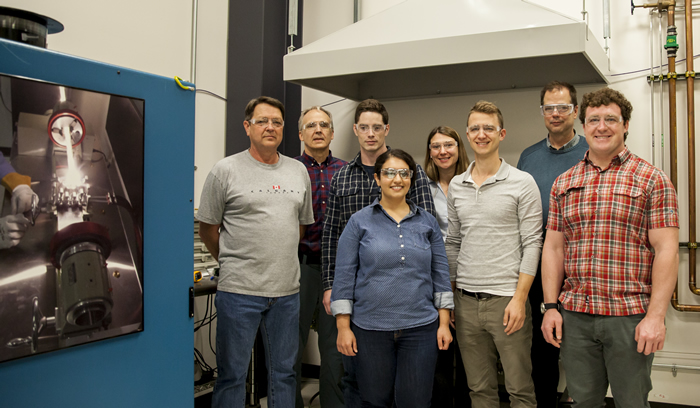 Members of the team developing eye-safer lasers in LLNL’s Fiber Draw Tower (from left): Nick Schenkel, Mike Messerly, Matthew Cook, Leily Kiani, Diana VanBlarcom, Reggie Drachenberg, Paul Pax, and Cody Mart. Not shown: Victor Khitrov, Diana Chen, and Charles Yu. Credit: Mark Meamber
Members of the team developing eye-safer lasers in LLNL’s Fiber Draw Tower (from left): Nick Schenkel, Mike Messerly, Matthew Cook, Leily Kiani, Diana VanBlarcom, Reggie Drachenberg, Paul Pax, and Cody Mart. Not shown: Victor Khitrov, Diana Chen, and Charles Yu. Credit: Mark Meamber Substantial progress has been made on two such lasers based on unique fiber designs that can achieve wavelengths in the eye-safer region, where the safety threshold is 100 to 1,000 times higher than at shorter wavelengths, according to NIF&PS physicist Reggie Drachenberg.
“This is a new area,” said Drachenberg, the team’s principal investigator of the latest results using a neodymium-fiber laser. “Nobody has gotten to one watt at this wavelength in a fiber and we have gotten to 10 watts—1,000 times higher than the previous record for neodymium at 1.4 microns—so we’re leading the pack by far.”
The immense potential power of laser light comes from its highly directional and coherent nature, with all the photons at the same wavelength and the crests and troughs of the light wave in lockstep. Laser light can remain concentrated for great distances and is able, for example, to reach to the moon and back.
The team has been working on Laboratory Directed Research and Development (LDRD) projects utilizing three commonly used laser materials: neodymium, erbium and ytterbium.
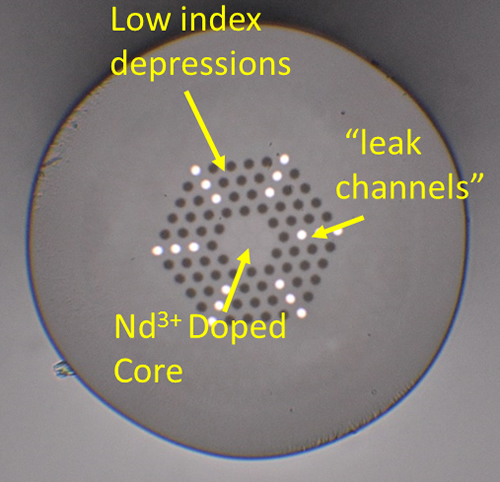 End-on photo of a neodymium optical fiber. The fiber has an outer diameter of 185 microns and a 21-micron-diameter neodymium-doped core at a wavelength of 1.4 microns.
End-on photo of a neodymium optical fiber. The fiber has an outer diameter of 185 microns and a 21-micron-diameter neodymium-doped core at a wavelength of 1.4 microns. Laser gain is achieved when the electrons in rare-earth fibers such as neodymium and erbium are excited by photons and jump to higher orbits around the nucleus. They eventually relax and emit light through a process called spontaneous emission. If relaxation is induced by interaction with an already generated “signal” photon, the process is called stimulated emission (laser is an acronym for “light amplification by stimulated emission of radiation”). Gain occurs when more energy is emitted than is lost due to waveguide and material losses.
Laser intensity typically is highest at the source and slowly decreases as it propagates over a long distance, Drachenberg explained. Any laser used near bystanders would need to be safe for a person to observe the scattering of light from a target while standing near the source, the location of highest intensity. Because this threshold increases at longer wavelengths, more power can be used and the capability to reach longer distances is increased.
Ytterbium lasers currently hold a dominant position in high-power fiber lasers due in part to their ability to absorb high-power pump light at the pump wavelength and efficiently emit light at one micron. But they have been shown to cause retinal damage by people looking either directly at the laser or at the scattered light at wavelengths shorter than 1.4 microns.
One of the two new laser designs calls for utilizing erbium, which is normally used for low-power telecommunications applications, because glass is most transparent where erbium emits light at 1.55 microns, in the eye-safer region. Erbium, however, has limited ability to absorb high-power pump light at the pump wavelength.
Combining Erbium and Ytterbium
A key to previous efforts in high-power erbium lasers has been to combine erbium and ytterbium in the same fiber. This has led to a 300-watt result at the University of Southampton in the UK. High power is achieved by pumping the ytterbium and transferring the energy to nearby erbium ions; this transfer is limited, however, and creates a bottleneck. At a high enough pump power, the ytterbium begins to lase, or emit light, at one micron. The researchers aim to improve this transfer efficiency and achieve higher power in erbium at 1.55 microns.
“The trick we’re trying to play,“ said NIF&PS physicist Victor Khitrov, “is that the energy has to transfer efficiently from the excited ytterbium atom to the erbium atom without bottlenecking at high powers.“
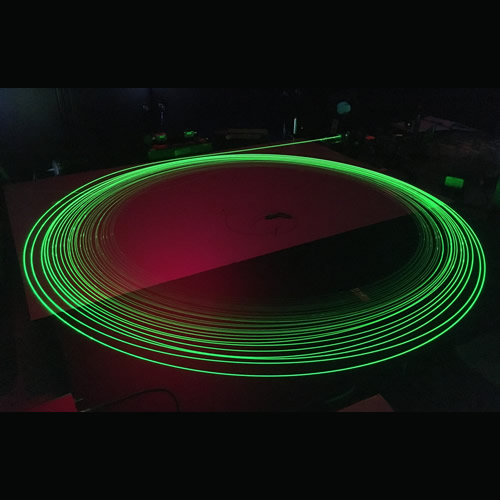 A defect-free stretch of fiber co-doped with erbium (Er) and ytterbium (Yb). The Yb allows absorption of commonly available high-power diode pump light at .98 microns, and the Er allows for emission at 1.55 microns in the eyesafer region after an ion-ion energy transfer.
A defect-free stretch of fiber co-doped with erbium (Er) and ytterbium (Yb). The Yb allows absorption of commonly available high-power diode pump light at .98 microns, and the Er allows for emission at 1.55 microns in the eyesafer region after an ion-ion energy transfer. This is important to the eye-safer laser development, Drachenberg explained, because the amplifier will emit most of its power at the wavelength with the most gain. The waveguide designs increase waveguide losses at undesired wavelengths to suppress gain at that wavelength, allowing a different and more desirable wavelength to have the most gain.
The researchers developed a process that selectively suppresses the gain below 1.4 microns, using a diode to amplify the power and essentially tricking the laser ions into emitting more light at longer wavelengths, Khitrov said. “Unlike previous efforts in erbium,” he said, “we will use wavelength selective waveguide designs to suppress one-micron gain and promote additional energy transfer from the ytterbium to the erbium for emission at 1.55 microns.”
The researchers have employed the materials in unique combinations or fiber designs they call “recipes.” They are developing one neodymium-based fiber laser at a wavelength of 1.4 microns and a power of 10 watts—the highest power to date for a neodymium-based fiber laser at that wavelength.
Neodymium at eye-safer wavelengths is new territory, and demonstrating moderate power scaling to tens or hundreds of watts is the team’s current goal, with kilowatt (1,000-watt) scaling reserved for future projects. For the erbium-ytterbium combination, the plan is to demonstrate power scaling beyond the record of 300 watts previously achieved at other institutions, Drachenberg said. With LLNL’s unique capabilities, the team members believe they can demonstrate power scaling up to one kilowatt.
While these lasers are in the eye-safer region, the scientists warn, they aren’t safe for a direct look straight into the laser. It’s the equivalent of looking at the lighted glow from a shaded lamp, but not directly at the bare bulb under the shade.
The many technology applications for these lasers include telecommunications, medicine, bioscience, materials processing, metrology, spectroscopy, and directed energy with important national defense applications. Another is LiDAR (light detection and ranging), a remote-sensing method that uses light from a pulsed laser to measure ranges, or variable distances, to the Earth or to surrounding objects. LiDAR is in demand for such newly emerging technologies as self-driving vehicles and airborne and ground-based archeology.
 Using LiDAR technology, archeologists recently discovered more than 60,000 hidden Maya ruins in Guatemala near the city of Tikal (left). The technology was used to survey digitally beneath the thick forest canopy, revealing houses, palaces, elevated highways, and defensive fortifications. Credit: Wild Blue Media
Using LiDAR technology, archeologists recently discovered more than 60,000 hidden Maya ruins in Guatemala near the city of Tikal (left). The technology was used to survey digitally beneath the thick forest canopy, revealing houses, palaces, elevated highways, and defensive fortifications. Credit: Wild Blue Media The waveguide design that enables this progress entails actually degrading guidance at selected wavelengths; that is, making them “leaky.” This is accomplished by connecting the core of the waveguide to the cladding by a “bridge” of wavelength-dependent resonant elements.
The designs were analyzed and developed by LLNL scientist Paul Pax, who has worked on related NIF&PS laser LDRD programs using a FEM (finite element method)-based mode-solving code and post-processing. This approach provided insight and resulted in designs tailored to the neodymium and erbium-ytterbium recipes. Drachenberg and Khitrov said using Pax’s modeling saved them considerable experimental time that could have taken weeks or even months for each laser.
The team credits another key solution to chemical engineer Diana VanBlarcom and the NIF Optics Processing Team. VanBlarcom saw that fibers were being contaminated by particulates when the rods were stacked outside a cleanroom. Particulate contamination in fiber lasers can result in many detrimental effects including energy losses, poor strength, and failure (breakage) at high power.
VanBlarcom developed a cleaning process for the individual laser rods which mimicked the cleaning and etching done on NIF’s ultraviolet optics. She also moved the stacking activity into a Class 100 cleanroom to maintain the cleanliness of components and prevent particulate contamination.
“I was happy I could leverage my knowledge of NIF optic processing,” VanBlarcom said, “and help the fiber laser team tackle some of their problems with fiber performance and reliability.”




